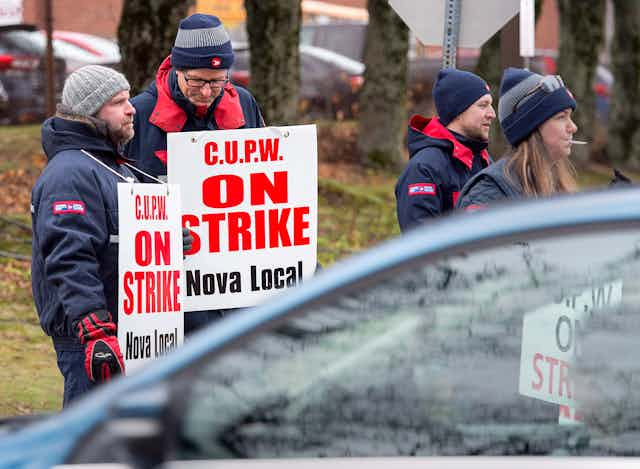Bill C-89 recently passed third reading in the Senate, its final hurdle before becoming law. The bill ended the rotating strikes that the Canadian Union of Postal Workers had engaged in for more than a month and sends the labour dispute to third-party, binding arbitration after a specified mediation period.
The bill was briefly held up over concerns that it was unconstitutional. The union says Bill C-89 is “a clear violation of workers’ Charter rights.” The Senate was ultimately unpersuaded.
It is accepted wisdom among labour relations scholars that freely negotiated settlements lead to better outcomes than imposed settlements. Whatever the labour relations wisdom of this bill, the question of whether it violates the Charter remains.
The Charter right to strike
In 2015, the Supreme Court of Canada expanded the scope of freedom of association under the Charter to include striking in support of collective bargaining.
Those arguing Bill C-89 is unconstitutional refer to the fact that postal service is not “essential.” They also cite a 2016 court ruling in which a similar bill (C-6) introduced by Stephen Harper’s Conservatives in 2011 was deemed unconstitutional.
While both of these facts are relevant, neither determines whether the present bill is unconstitutional.
Essential services
Federal Labour Minister Patricia Hajdu claims the postal service is “essential” and the rotating strikes were harming small and medium-sized enterprises.

Under international labour law, “essential services” are defined narrowly. Previous attempts to expand the definition of essential to include economic harm caused by a strike have been decisively rejected by the International Labour Organization’s Committee on Freedom of Association. And the Supreme Court of Canada has explicitly endorsed the restricted definition of “essential services” found under international labour law.
When it comes to labour law, the term “essential” is a loaded one. And it isn’t obvious whether the minister intends for the term to be understood in its legal, or some other, sense. And maybe it doesn’t matter.
That’s because in 2016, the court determined that even strikes in non-essential services could be restricted.
Different than previous bill?
Hajdu maintains, in fact, that Bill C-89 is different from Bill C-6, ruled unconstitutional in 2016. Under Bill C-6, terms that were central to the bargaining impasse were removed from the arbitrator’s purview and imposed by the government. Additionally, Bill C-6 allowed for the unilateral appointment of the arbitrator by the government’s labour minister at the time, Lisa Raitt.
Bill C-89 appears to avoid both problems. First, it “does not impose immediate outcomes.” It does provide a list of “principles” that an arbitrator must consider in its determination, but that’s not unusual. Moreover, these principles acknowledge the concerns of both the union and the corporation.
Bill C-89 allows for the unilateral appointment of an arbitrator only in the event that both parties cannot agree upon one, and even then, only after consultation with the chair of the Canadian Industrial Relations Board.
Contrast this to the previous unilateral appointment process, whereby two successive appointees were challenged by the union. The first recused himself, and the second was ordered to do so by a federal court judge owing to a reasonable apprehension of bias.
Bill could still face uphill battle
The fact that strikes may be restricted even in non-essential services, and that the arbitration process might pass constitutional muster, doesn’t mean that other Charter principles don’t apply. The government must demonstrate that its legislation has a pressing and substantial purpose, and that it is proportional.
In 2016, Bill C-6 was considered unconstitutional because it failed one aspect of the “proportionality” analysis — that is, it impaired the Charter rights of the striking workers more than was necessary to achieve its purpose.
Much depends upon how a court defines the government’s “purpose” and how it chooses to understand the relationship between that purpose and the requirement to only minimally impair Charter rights.
Among other things, a court might consider that the strike activity itself was minimal given that the union had very purposely chosen rotating strikes rather than a complete labour withdrawal.
The court might also consider that Canada Post is not a monopoly and that consumers and businesses have alternatives available to them. This could weigh against the notion that the total prohibition on strikes required by Bill C-89 is minimally impairing.
For these reasons, a constitutional challenge could still prove successful. In any event, a court tasked with determining whether Bill C-89 violates Charter rights should be very careful about what a low bar for government intervention it could be setting, all things considered.
Strikes not all bad
Strikes are necessarily inconvenient. But they also have benefits. Aside from providing a means to address workers’ legitimate concerns, those benefits often ripple beyond the union membership itself.
Notably, the postal worker strike in the early 1980s won for union members expanded maternity rights, which in turn pressured the government to follow suit.
And when faculty strike over class sizes or to highlight their precarious employment, the potential effect is to improve the learning conditions for all students.
While not every strike might carry with it far-reaching positive implications, we should be very circumspect about intervention into the bargaining process, and skeptical about government claims that intervention is the best way to protect the public interest.

